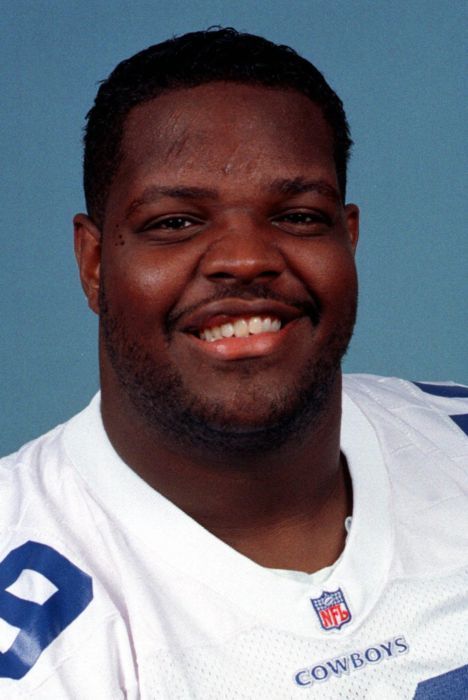When you talk about the Dallas Cowboys of the 1990s, certain names come to mind instantly: Troy Aikman, Emmitt Smith, Michael Irvin. These were the offensive stars whose plays filled highlight reels and whose names were etched into Pro Football Hall of Fame lore. But ask the men who stood in the trenches, the ones who fought for inches in the brutal war zone known as the line of scrimmage, and they’ll tell you: none of those stars shine without the man they called “Big E.”
Erik Williams didn’t need a camera to be a force. His legacy wasn’t built on soundbites or celebrations. It was built on bruises—left behind on the bodies and egos of the defenders who dared line up across from him. He was raw, unfiltered power. A right tackle with the mindset of a middle linebacker and the fury of a freight train. He didn’t just block. He obliterated. He didn’t just win matchups. He ended them.
Born out of Central State University in Ohio, a small-school program far from the national spotlight, Williams entered the 1991 NFL Draft with little fanfare. He was taken in the third round by the Dallas Cowboys, who were quietly assembling a nucleus that would soon become one of the greatest dynasties the NFL had ever seen. But even Jerry Jones and Jimmy Johnson couldn’t have fully known what they were getting in Erik Williams: a player who would change the way the right tackle position was viewed — and feared.
From the first time he put on a Cowboys jersey, it was clear Williams wasn’t your typical lineman. He brought a ferocity that bordered on violent — and that’s exactly what made him special. The offensive line is often called the most selfless unit in football, and that’s true. But Williams added something else: intimidation. He set the tone. He threw the first punch — metaphorically and, occasionally, literally. He didn’t just protect his quarterback; he dared you to try to hurt him.
By the early ‘90s, with Williams anchoring the right side, the Cowboys were emerging as a juggernaut. The offense flowed with surgical precision, and Emmitt Smith was rewriting the NFL’s rushing record books. Much of that ground game success began behind Williams, who paved highways through defensive fronts with a mixture of perfect technique and unrelenting force. When you had to go north-south in a short-yardage situation, you went behind #79. Everyone knew it — and no one could stop it.
Then came 1992, the true beginning of the dynasty. The Cowboys stormed their way to a Super Bowl XXVII title, and Williams, now a full-time starter, was already becoming one of the most feared linemen in football. But it was the 1993 season that catapulted him into legend — the year he faced off against Reggie White.
Reggie White. The Minister of Defense. A future Hall of Famer. A man who made offensive tackles across the league look foolish, weak, helpless. Except when he lined up across from Erik Williams. In a game that has since become the stuff of NFL folklore, Williams not only held his own — he dominated. Snap after snap, Williams stonewalled White with a ferocity rarely, if ever, seen before or since. He frustrated him. He physically imposed his will on him. And for perhaps the only time in his illustrious career, Reggie White looked human.
It wasn’t just about strength. It was about attitude. Williams came into every game looking to deliver punishment. He was the enforcer, the gatekeeper, the bouncer at the nightclub nobody wanted to mess with. That mindset earned him back-to-back First-Team All-Pro selections in 1993 and 1994, and four trips to the Pro Bowl. More importantly, it helped the Cowboys claim three Super Bowl championships in four seasons — a level of dominance unmatched in the salary cap era.
But greatness, especially in the NFL trenches, often comes with a price. For Erik Williams, that price came in the form of a devastating car accident in October of 1994. He suffered a torn ACL and multiple facial injuries. It was a crash that could have easily ended his career — or worse, his life. At the peak of his power, the anchor of the Dallas offensive line was suddenly facing a long, grueling road back.
For many players, it would’ve been the end. For Williams, it was just another battle.
He missed nearly a full season recovering, his future uncertain. But he didn’t fade quietly. With that same relentless grit that defined his blocking, he worked his way back onto the field. He wasn’t quite the same physically — how could he be after such trauma? But mentally, he was still a warrior. Still the man you didn’t want to see across the line on Sunday.
Even after the accident, Williams remained a valuable and intimidating presence. The Cowboys won their third Super Bowl with him back on the roster, and though injuries and wear began to take their toll, he never lost his edge. He brought leadership to the locker room, tenacity to the field, and pride to a franchise that demanded excellence.
His name may not be in the Hall of Fame — and that’s a conversation that continues to generate strong opinions — but his impact on the game is undeniable. He changed the standard. He made people look differently at right tackles. He redefined the role, proving it wasn’t just about being technically sound, but being downright dangerous. Offensive line play, particularly on the right side, was never the same after Erik Williams.
And for Cowboys fans, his contributions will forever be etched into the identity of those 1990s teams. While Aikman was the brain, and Emmitt the heart, Erik Williams was the fists. He was the force behind the flash, the grit behind the glory. He didn’t seek attention — but he demanded respect.
Go back and watch the games. You’ll see him mauling defenders, pancaking All-Pros, standing over the pile like a gladiator. You’ll see the swagger, the violence, the pride. You’ll see a man playing a position as if it were personal. Because for Williams, it always was.
His opponents feared him. His teammates trusted him. His franchise relied on him. And to this day, Cowboys fans revere him.
Erik Williams didn’t just help define a dynasty. He embodied it. He was the anchor of a legendary line, the protector of legends, and the very embodiment of Dallas toughness. His story — from third-round pick out of a tiny school, to the most feared man in the trenches, to survivor and champion — is one of the greatest underappreciated tales in NFL history.
So remember #79. Remember the blood, the bruises, the battle scars. Remember the man who made grown defenders look like they didn’t belong on the same field. Remember Erik Williams not just as a Cowboy — but as a warrior whose fury and fearlessness helped build a dynasty.
Forever a Cowboy. Forever a warrior. Forever feared.



